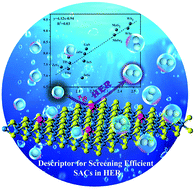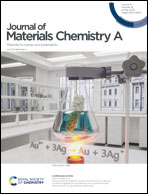Rational design of an efficient descriptor for single-atom catalysts in the hydrogen evolution reaction†
Abstract
The electrocatalytic hydrogen evolution reaction (HER) is essential for future renewable and clean energy technology. Screening low-cost and highly active catalysts efficiently, however, is still a grand challenge. Herein, we symbolize a highly efficient guiding principle to govern the electrocatalytic activity of single-atom catalysts (SACs) based on AX (A = Al, Ga, In, and Tl; X = S and Se), BX2 (B = Mo and W) and ZrS2 monolayer substrates for the HER. Our results reveal that the catalytic performance of SACs for the HER is highly correlated with the electronegativity of the active site and its neighboring atoms as well as the distance between them. The descriptor was introduced to determine the activity of SACs for the HER, where the generalized principle can help to predict and design efficient electrochemical catalysts for hydrogen generation. More importantly, the identified descriptor can be acquired only from initial structures of the materials without considering other complicated processes involved in the HER, which is beneficial for screening catalysts more conveniently and quickly. Such an efficient descriptor, whose reliability has been demonstrated by more than 100 cases, may have potential applications in constructing efficient and low-cost SACs both theoretically and experimentally.



 Please wait while we load your content...
Please wait while we load your content...